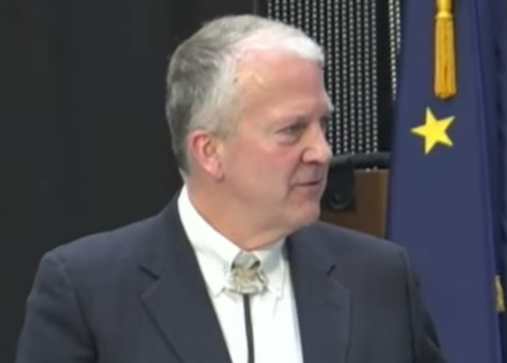
Photo by John Yarie.
This spring, John Yarie learned of the death of the oldest living things he knew. Since 1988, the silviculture professor at the University of Alaska Fairbanks had measured and fertilized a stand of giant spruce trees on a hillside south of Fairbanks. A few weeks ago, forest technicians visited the site and found that one dozen trees had been cut down, possibly by “wood poachers.”
“I’m just really disappointed somebody would come in and do something like that,” Yarie said. “It ended all the data collection going on for that site.”
The trees were part of a long-term research plot in the 12,487-acre Bonanza Creek Experimental Forest between Fairbanks and Nenana. The 200-year-old trees had aluminum tags on them at chest level and were encircled with silver dendrometer bands that measured tree growth. They were located a few hundred yards off a dirt road, miles from legal woodcutting areas. Whoever cut the trees left the top portions, some of which were 10 to 12 inches in diameter.
A few of the 50-inch diameter trees had been absorbing carbon dioxide and emitting oxygen since 1813. Forest expert Glenn Juday of the University of Alaska Fairbanks said mid-slope white spruce trees don’t get much older, because fire sweeps through every 200 years or so.
Yarie, 65, helped establish the plot on a south-facing hillside when he was 39. He then measured every tree in the 15-meter by 15-meter square, and has gone back to check the growth of the white spruce every five years. Each year, he or forest technicians have fertilized part of the plot to see how the trees responded (not much) to more nitrogen in comparison to a nearby untouched control plot.
“That site is now done,” said Jamie Hollingsworth, manager of the Bonanza Creek Experimental Long-Term Ecological Research site for 11 years. “That data point is no longer there.”
Hollingsworth said the old-growth white spruce and the time people had put into the research made the plot a valuable one.
“Twenty-five years worth of man-hours is a lot of money,” he said.
Hollingsworth, who spends much of his time outdoors as he maintains sites for scientists, has seen “wood poachers whittling away” at the state-owned experimental forest, especially since a jump in home heating oil prices in 2007 and 2008. Because managers of the Bonanza Creek Experimental Forest set it up in 1963 for multiple uses, foresters can’t put up gates to prevent people from driving in to the remote site off the Parks Highway.
“We can put up signage, but a sign isn’t going to stop someone who doesn’t care,” Hollingsworth said.
Yarie also wonders if the loss of the trees is due to the “firewood craze” in Interior Alaska.
“You can start tying this all in to population growth,” he said. “When you go from a town of 10,000 to a town of 100,000, there have to be changes.”
Those changes might include regulations on wood harvesting similar to bag limits on moose and fish, Yarie said.
The big loss that happened in a few moments was what those trees might tell people about the long-term white spruce ecosystems in Interior Alaska. Forestry studies often yield the best information after generations of people work on them, Yarie said.








